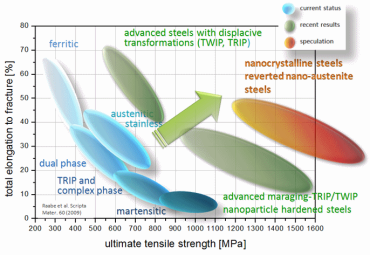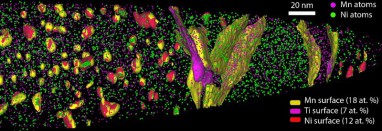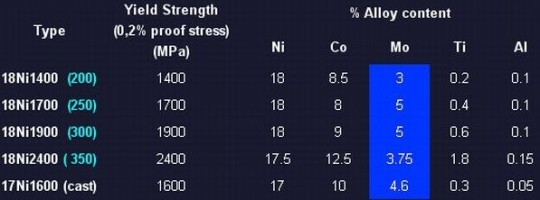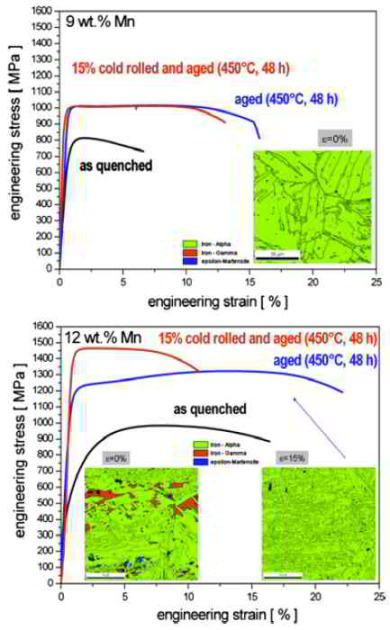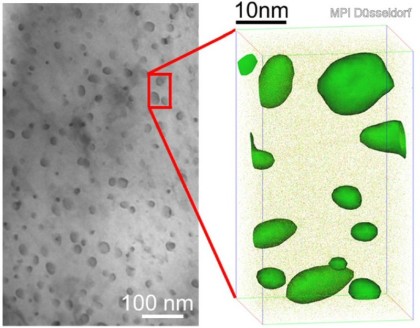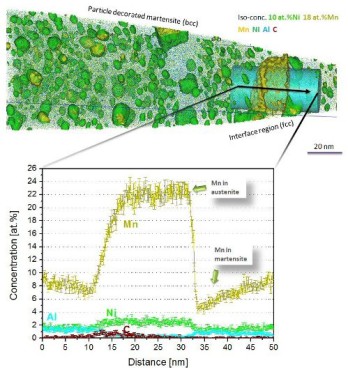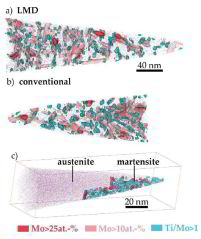Maraging Steels and Maraging TRIP Steels
What does the word 'Maraging' stand for ?
Maraging refers to a combination of 'martensite' and 'aging', more specific, maraging describes an alloy design strategy that is based on a heat treatment which involves the age hardening of a low carbon Fe-Ni or Fe-Mn martensite.
What are Maraging Steels?
Commercial maraging steels are carbon free iron-nickel alloys with minor doping additions of cobalt, molybdenum, titanium and aluminium. The word 'maraging steel' derives from the underlying strengthening mechanisms, namely, (a) transformation of the face centered cubic high temperature austenite phase of such alloys into cubic martensite combined with (b) the subsequent age hardening of this as-quenched material, hence, mar(tensite)-aging.
Air cooling the austenite to room temperature from about 820°C creates a soft iron nickel cubic martensite, which contains molybdenum, aluminium, titanium and cobalt in supersaturated solid solution. Tempering this relatively soft martensite at 480 to 500°C results in strong age hardening due to the nano-precipitation of a high number density of intermetallic phases, including, nickel-molybdenum, iron-molybdenum and iron-nickel phases, typcially with near B2 and DO3 structures, yet, with often non-stoichiometric sublattice occupation.
The standard commercial grades with 18wt.% nickel and additions of cobalt and molybdenum were developed as early as around 1950.
When were Fe-Ni based maraging steels developed?
The first maraging steels introduced in the end of the 1950s and in the 1960s were of high interest owing to their good combination of toughness and ease of fabrication with very high strength.
Hardness of maraging steels
Maraging Steel is two times harder than stainless steel and 85% harder than pure titanium. Maraging steel alloys are twice as hard as stainless steel and 35% stronger than the hardest titanium alloy. On the Rockwell Scale of Hardness, stainless steel is 23-26, titanium alloys 28-41 and Maraging Steel 52-55.
Maraging steel 250
Maraging steels are often abbreviated and grouped in terms of numbers, i.e. 200, 250, 300 or 350, which indicates the approximate nominal tensile strength in thousands of pounds per square inch;
the compositions and required properties are defined in the spec norm MIL-S-46850D.
Maraging steel 250 is an 18 wt.% nickel steel that has been strengthened with cobalt. Maraging 250, like all maraging steels, goes through an aging process that forces the metal to cool from its
molten state to its solid state over an artificially long time. This process results in tempered steel that has both high levels of strength and hardness. It will also resist certain stresses and
maintain its structure in environments that would cause irreparable changes to many other steels. The properties that make Maraging 250 particularly appealing to many industries is its workability.
This allows Maraging 250 to be more versatile than many other alloys in its class. However, it is still the alloy’s strength and resistance to extreme temperatures that make it a truly effective
material in a wide range of atmospheres. After Maraging 250 has undergone heat treatment, it demonstrates excellent mechanical properties. It will reach a yield strength of 240 ksi and a fracture
toughness of 75 k1c. These properties have made Maraging 250 effective in the construction of missile and rocket motor cases, landing and takeoff gear, and high performance shafting.
Maraging steel 300
Maraging steel 300 is an iron-nickel steel alloy that, as with all maraging steels, exhibits high levels of strength and hardness. However, Maraging 300 also possesses an extreme resistance to crack propagation, even in the most extreme environments. Maraging 300 is often used in applications where high fracture toughness is required or where dimensional changes have to remain at a minimal level. The unique properties of Maraging 300 have made it an integral part of the aircraft and aerospace industries. It is often used in rocket motor casings and the landing gear for certain planes. Maraging 300 is also effective in the design of power shafts and low-temperature cooling systems.
Maraging steel 350
Maraging steel 350 refers to crystalline tempered steel. Martensite, which is created through an aging process. When aging is used, steel is forced to cool from its molten state to its solid state over a prolonged period of time. The result is a metal that is harder and stronger than it would be had the steel been allowed to cool at a natural rate. Maraging 350 is an alloy that has become an integral material in the airplane and aerospace industries. Due to its strength and its ability to withstand extreme conditions including frequent and sudden changes in speed and temperature, Maraging 350 is used in the production of rocket motor cases, takeoff and landing gear, and certain munitions created by defense companies. Maraging 350 also has uses in less drastic applications such as die casting and high performance shafting.
Maraging steel 362
Maraging steel 362 is known for their exceptional strength and hardness. Their ability to resist various forms of stress in extreme environments has made maraging steels commonplace in the aerospace and aircraft industries. Each maraging alloy has its own unique qualities, but many of them are used in similar applications. Maraging 362, like other maraging steels, undergoes an artificial aging process. This process leads to the material’s added strength and hardness. The results of the aging procedure has recently caught the eye of golf club designers and manufacturers who have begun to use maraging alloys on the faces of their clubs in the hope that players will see increased power and that clubs will not corrode over time. Maraging steel gives you an elevated level of strength, hardness, and ductility. These steels are created through an aging process that results in the development of a hard, brittle crystalline called martensite. The term “maraging” is, in fact, a simple combination of martensite and aging. The construction of maraging steel allows it to withstand atmospheres that would quite simply destroy most standard steel. The aging process instils maraging steel with the ability to withstand sudden changes in speed and temperature, even at extreme levels. This quality has made maraging steel alloys an important component of many of the air and spacecraft used today.
What types of maraging steels exist and how are they produced?
Many Ni and Mn-based maraging steels with property spectra including particularly high toughness and strength have been developed.
For optimum strength and toughness, critical elements such as carbon, silicon, manganese, sulfur, and phosphorus are restricted to very low levels which renders synthesis and metallurgical refinement
of such alloys challenges. Also, the number density of non-metallic inclusions must be reduced to an absolute minimum.
The maximum amounts typcially specified in commercial maraging steels are (in wt. %): carbon 0.03, silicon 0.1, manganese 0.1, sulfur 0.01, phosphorus 0.01. Since the same metallurgical principles
apply to all the grades the steels can be considered as a family of low carbon iron-nickel alloys containing a variety of age hardening elements.
The density of maraging steel is equivalent to 8 gm/cm3 and the melting point is 1413°C. Conventional maraging alloys are steels containing 18% Ni. These alloys are produced by vacuum melting and it
can be converted into the mill product forms such as like billets, bars, rods, coils, and wires. It is most suitable for die castings. It has superior ductility, toughness, low coefficient of thermal
expansion and elasticity, excellent tempering resistance, good corrosion resistance and thermal conductivity. The benefits of maraging steels are its excellent resistance to heat checking and small
stresses in thermal cycling, less softening in use, less erosion and oxidation.
Typical applications of maraging steels
Maraging steels are considered as the best tooling materials. It possess excellent mechanical properties like higher yield strength and UTS. Besides, it has higher impact strength, fatigue
strength, compressive strength, toughness, ductility, hardness, and wear resistance. It has excellent machinability characteristics and readily cold and hot formed. Maraging steels are highly
resistant to crack propagation and possess good wettability and polishability. For heat treating, maraging steels require lower furnace temperature. Uniform and predictable shrinkage occurs during
heat treatment. Minimal distortion occurs during thorough hardening and free from the formation of carburized or decarburized layers on its surface. Maraging steels have the unique combination of
ultra high yield and tensile strength, ductility, and fracture toughness of any ferrous materials. It can retain its strength up to 350 degree centigrade. Having a very low carbon martensite, the
structure is soft and readily machinable. It can be surface hardened by nitriding. Maraging steels are typically applied to produce missile and rocket motor cases, wind tunnel models, recoil springs,
flexures, AC Motors, landing gear components, high performance shafting gears and fasteners, extrusion tools, casting dies, and core pins. Engine components such as crankshafts and gears that work at
warm temperatures and the firing pins of automatic weapons that cycle from hot to cool repeatedly while under substantial loads and impacts are made from maraging steels. Their uniform expansion and
ease machinability characteristics makes it useful in high wear portions of assembly lines and as well as in die manufacturing.
Maraging Steel alloys have been available to the golf industry for years. The purpose of utilizing thin maraging steel face inserts allow the face to flex to produce a high coefficient of restitution
or rebound effect, just like the use of titanium in modern drivers as a way to increase the ball velocity coming off the face. In addition, there is a considerable weight savings that allows the golf
club designer to place more weight elsewhere in the head to improve launch angles and reduce spin rates. Maraging steel is used in lieu of titanium because it is easily bonded to a stainless frame in
fairway woods, hybrids and irons.
Classical References on Conventional Maraging Steels:
- Decker, R. F., Eash, J. T., and Goldman, A. J., “Eighteen Percent Nickel Maragin Steel,” Trans. ASM, 55,58-76 (1962).
- Decker, R. F., Novak, C. J., and Landig, T. W., “Developments and Projected Trends in Maraging Steels,” Jnl. Metals, 19 (11), 60-66 (1967).
- Sadowski, E. P., “12% Ni Maraging Steel,” Metals Eng. Quart, 5,56-64(1965)
Concept for the design of Maraging-TRIP steels
Advanced high strength steels can be designed via stimulating athermal transformations during deformation such as martensite formation or twinning in unstable austenite, or, alternatively, by
introducing nanoscale precipitates. The first types of steels are referred to as TRIP and TWIP steels and the latter ones as maraging or nano-precipitate steels (TRIP: transformation-induced
plasticity; TWIP: twinning-induced plasticity; maraging: martensite aging through thermally stimulated precipitation of particles).
In an effort to exploit both effects for obtaining improved strain hardening, namely, athermal transformations and precipitates, we designed a novel class of materials that we call maraging-TRIP
steels. These are precipitation hardened ductile high strength austenitic-martensitic TRIP steels with up to 1.5 GPa strength and total elongations between 15% and 20%.
The alloys have a low carbon content (0.01 wt.% C), 9-15 wt.% Mn for designing different levels of retained austenite volume fraction and stability, and minor additions of Ni, Al, Ti, and / or Mo
(1-2 wt.%). The latter elements are used to create precipitates in the martensite during aging. The nanostructure design of the material proceeds by homogenization in the austenitic phase followed by
quenching. Depending on the Mn and Ni content the resulting microstructure is either fully martensitic (as in conventional maraging steels) or martensitic with some fraction of retained austenite.
After quenching the material is heat treated at a temperature 100-150 K below the bulk re-austenitization temperature to create nanoparticles in the martensite (usually at 450°C).
Upon loading, strain hardening in these materials is realized by combining the TRIP effect (of the unstable austenite) with particle hardening (of the martensite). More specific, the TRIP mechanism
is here based on the deformation-stimulated athermal transformation of metastable austenite into nearly cubic martensite and the resulting matrix and martensite plasticity required for accommodating
this transformation misfit. The maraging treatment is based on the hardening of the quenched-in martensite through the formation of small intermetallic precipitates. The size of these particles is of
the order of several nanometers as revealed by atom probe tomography.
Interestingly, the atom probe analysis of retained austenite-to-martensite interfaces and also of Mn-decorated martensite grain boundaries revealed, that pronounced austenite reversion can take place
during aging (e.g. at 450°C, 48 h), i.e. far below bulk re-transformation to austenite. This means that during the martensite aging heat treatment both, precipitation in the martensite and austenite
reversion take place. It is worth noting that the occurrence of two types of austenite with different stability (retained, reversed) leads to a broader deformation regime where the TRIP effect
occurs. This mechanism seems to promote ductility.
Hence, the combination of the various mechanisms pointed out above in the form of Fe-Mn maraging TRIP steels, namely, the precipitation hardening of martensite and the transformation-induced
formation of martensite in both, retained and reversed austenite opens a novel and lean alloy path to the development of ultrahigh strength steels.
Wang et al Acta 2014 smaller is less sta[...]
PDF-Dokument [1.2 MB]
Acta Materialia 79 (2014) 268
Steels containing reverted nanoscale austenite (cRN) islands or films dispersed in a martensitic matrix show excellent strength,
ductility and toughness. The underlying microstructural mechanisms responsible for these improvements are not yet understood, but are observed to be
strongly connected to the cRN island or film size. Two main micromechanical effects are conceivable in this context, namely: (i) interaction of cRN with microcracks from the matrix
(crack blunting or arresting); and (ii) deformation-induced phase transformation of cRN to martensite (TRIP effect). The focus here is on the latter phenomenon.
To investigate size effects on cRN transformation independent of other factors that can influence austenite stability (composition, crystallographic orientation, defect density,
surrounding phase, etc.), a model (TRIP-maraging steel) microstructure is designed with support from diffusion simulations (using DICTRA software) to have
the same, homogeneous chemical composition in all cRN grains. Characterization is conducted by in-situ tension and bending experiments in conjunction with high-resolution electron backscatter
diffraction mapping and scanning electron microscopy imaging, as well as post-mortem transmission electron microscopy and synchrotron X-ray diffraction analysis. Results reveal
an unexpected “smaller is less stable” effect due to the size-dependent competition between mechanical twinning and deformation-induced
phase transformation.
B2 NiMn and Ni2MnAl Heusler nanoprecipitates are designed via elastic misfit stabilization in Fe–Mn maraging steels by combining transmission electron microscopy (TEM) correlated atom probe tomography (APT) with ab initio simulations.
Acta Materialia 2014 maraging steel Heus[...]
PDF-Dokument [4.9 MB]
Acta Materialia 76 (2014) 94
B2 NiMn and Ni2MnAl Heusler nanoprecipitates are designed via elastic misfit stabilization in Fe–Mn maraging steels by combining transmission electron microscopy (TEM)
correlated atom probe tomography (APT) with ab initio simulations. Guided by these predictions, the Al content of the alloys is systematically varied, and the influence of the Al
concentration on structure stability, size and distribution of precipitates formed during ageing at 450 °C is studied using scanning electron microscopy–electron backscatter diffraction,
TEM and APT. Specifically, the Ni2MnAl Heusler nanoprecipitates exhibit the finest sizes and highest dispersion and hence lead to significant strengthening. The formation of the
different types of precipitates and their structure, size, dispersion and effect on the mechanical properties of the alloys are discussed.
Designing Ultrahigh Strength Steels with Good Ductility by Combining Transformation Induced Plasticity and Martensite Aging
ADV_ENGIN_MATER_2009_11_page_547_maragin[...]
PDF-Dokument [1.7 MB]
Segregation engineering enables nanoscale martensite to austenite phase transformation at grain boundaries: A pathway to ductile martensite
Acta-Mater-Nano-Austenite-reversion-2013[...]
PDF-Dokument [6.0 MB]
Scripta Materialia 60 (2009) 1141-1144
Nanoprecipitate-hardened 1.5 GPa steels with unexpected high ductility
D. Raabe, D. Ponge, O. Dmitrieva, B. Sander
2012_Steel_Atom-Probe-Microscopy-Today-0[...]
PDF-Dokument [744.4 KB]
We present mechanical and microstructure results on precipitation-hardened ductile high-strength martensitic and austenitic-martensitic steels (up to 1.5 GPa strength) with good ductility. The alloys have a low-carbon content (0.01 wt.% C), 9–12 wt.% Mn, and minor additions of Ni, Ti and Mo (1–2 wt.%). Hardening is based on transformation-induced plasticity and the formation of intermetallic nanoprecipitates in the martensite during heat treatment (aging). The approach leads to an unexpected simultaneous increase in both strength and total elongation.
Steels with very high strength above 1 GPa and good ductility (total elongation of 15–20% in tensile testing) are future key materials for lightweight engineering
solutions and corresponding CO2 savings. We present surprising results on low-alloyed materials that were developed by combining the transformation-induced
plasticity (TRIP) effect with the martensite aging (maraging) effect. The TRIP mechanism exploits the deformation-stimulated transformation of unstable austenite into martensite and
the resulting plasticity required to accommodate the transformation misfit. The maraging effect uses the hardening of the heavily strained martensite through the formation of nanosized
intermetallic precipitates. These precipitations act as highly efficient obstacles to dislocation motion thereby enhancing the strength of the material. While both types of
alloys, i.e. TRIP steels and maraging steels, have been investigated in some depth, the combination of the two mechanisms has not yet received much attention.
The combination of the TRIP and maraging concepts in one alloy is alone sufficient to justify a detailed study as it promises an approach to enhance the strength of conventional steels
without the use of large quantities of expensive alloying elements. Unfortunately, the downside of this approach is that the increase in strength is usually accompanied by a drop in
ductility, quantified here in terms of the total elongation. However, surprisingly, the opposite trend is observed in the present case: we observed the simultaneous increase in strength and ductility upon formation of nanoscaled precipitates. The materials studied
combine different hardening mechanisms. The first one is the formation of strain-induced martensite (alloys with 0.01 wt.% C and 12 wt.% Mn
have retained austenite fractions up to 15 vol.%) and exploits the same hardening principles as
TRIP steels. The second one is the strain hardening of the ductile low carbon a0- and e-martensite and of the remaining retained austenite. The third one is the formation of nanosized intermetallic precipitates in the martensite
during heat treatment (i.e. maraging). These precipitates are highly dispersed owing to the favorable nucleation conditions in the heavily strained martensite
matrix in which they form. The steels show not only excellent mechanical properties but also an unexpected relationship between strength and total elongation as both quantities
increase upon aging. In addition to the optimization of yield strength, ultimate tensile strength and elongation to fracture, we also are trying to make a material that
is characterized by homogeneous strain hardening. Here we report results for a 9 wt.% Mn and a 12 wt.% Mn alloy (9Mn: 8.86 wt.% Mn, 0.0065 wt.% C, 2.0 wt.% Ni, 1.07 wt.% Mo, 1.04
wt.% Ti, 0.047 wt.% Si, 0.086 wt.% Al; 12Mn: 11.9 wt.% Mn, 0.0101 wt.% C, 2.06 wt.% Ni, 1.12 wt.% Mo, 1.09 wt.% Ti, 0.057 wt.% Si, 0.116 wt.% Al). Both alloys have a very
low-carbon content and minor additions of Ni, Ti and Mo which are required to form the nanoprecipitates. The difference among the samples consists in their Mn content (9 wt.%, 12
wt.%), and hence in the amount of retained austenite.
Nanoprecipitate-hardened 1.5 GPa steels with unexpected high ductility
Scripta Materialia 60 (2009) 1141 maragi[...]
PDF-Dokument [342.1 KB]
nano-Partitioning across phase boundaries between martensite and austenite in steel studied by atom probe tomography and simulation
2011_Acta_Materialia_APT_Steel-Fe-Mn.pdf
PDF-Dokument [2.3 MB]
Dierk Raabe German-Chinese Workshop IMR [...]
PDF-Dokument [1.8 MB]
Maraging Steel Micro- and Nanostructure Produced Conventionally and by Laser Additive Manufacturing
Maraging steels are used to produce tools by Additive Manufacturing (AM) methods such as Laser Metal Deposition (LMD) and Selective Laser Melting (SLM). Although it is well established that dense parts can be produced by AM, the influence of the AM process on the microstructure - in particular the content of retained and reversed austenite as well as the nanostructure, especially the precipitate density and chemistry, are not yet explored. In this specific project, we study these features using microhardness measurements, Optical Microscopy, Electron Backscatter Diffraction (EBSD), Energy Dispersive Spectroscopy (EDS), and Atom Probe Tomography (APT) in the as-produced state and during ageing heat treatment. We find that due to microsegregation, retained austenite exists in the as-LMD- and as-SLM-produced states but not in the conventionally-produced material. The hardness in the as-LMD-produced state is higher than in the conventionally and SLM-produced materials, however, not in the uppermost layers. By APT, it is confirmed that this is due to early stages of precipitation induced by the cyclic re-heating upon further deposition—i.e., the intrinsic heat treatment associated with LMD. In the peak-aged state, which is reached after a similar time in all materials, the hardness of SLM- and LMD-produced material is slightly lower than in conventionally-produced material due to the presence of retained austenite and reversed austenite formed during ageing.

